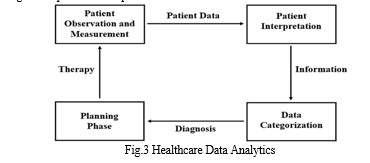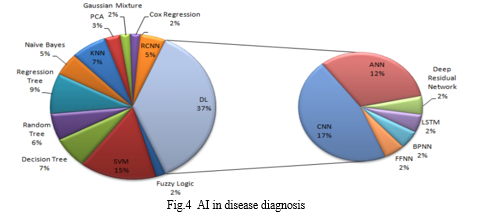Ijraset Journal For Research in Applied Science and Engineering Technology
- Home / Ijraset
- On This Page
- Abstract
- Introduction
- Conclusion
- References
- Copyright
Disease Detection and Treatment Susceptibility by AI
Authors: Simran Dhankar, Utkarsh Jain, Vansh Bansal, Prof. Naved Ahmad
DOI Link: https://doi.org/10.22214/ijraset.2024.58647
Certificate: View Certificate
Abstract
Artificial Intelligence (AI) has revolutionized disease detection and treatment susceptibility assessment in healthcare. This paper provides an in-depth analysis of AI applications in these domains, exploring its role in improving diagnostic accuracy, predicting treatment responses, and personalizing patient care. Leveraging machine learning, deep learning, and natural language processing, AI algorithms analyze diverse medical data sources to identify disease indicators and tailor treatment regimens. This paper reviews existing literature, presents methodologies employed in AI-driven disease detection and treatment susceptibility assessment, discusses key findings, and provides the latest statistics. By understanding AI\'s transformative potential, healthcare stakeholders can harness its capabilities to enhance patient outcomes and healthcare delivery.
Introduction
I. INTRODUCTION
In the ever-evolving landscape of healthcare, the integration of cutting-edge technologies has become imperative for enhancing diagnostic accuracy, treatment efficacy, and patient outcomes. Among these technologies, Artificial Intelligence (AI) stands at the forefront, promising to revolutionize disease detection and treatment susceptibility assessment. With its ability to process vast amounts of data, identify complex patterns, and generate actionable insights, AI has emerged as a powerful tool in the hands of healthcare practitioners and researchers alike.
The convergence of AI with healthcare has unleashed a wave of innovation, propelling the field towards personalized and precision medicine paradigms. Traditional approaches to disease detection and treatment often rely on standardized protocols, which may not adequately account for individual variations in genetic makeup, environmental factors, and lifestyle choices. AI, however, offers a paradigm shift by enabling the analysis of multifaceted data streams to tailor interventions according to the unique characteristics of each patient. At the heart of AI-driven healthcare lies its capacity for predictive modeling and risk assessment. By leveraging advanced machine learning algorithms, AI systems can sift through vast repositories of patient data, including electronic health records, medical imaging scans, genomic sequences, and wearable sensor data, to identify subtle patterns indicative of disease onset or progression. Moreover, AI facilitates the early detection of pathological conditions, enabling timely interventions that can significantly impact patient prognosis and quality of life. One of the most promising applications of AI in healthcare is in the realm of treatment susceptibility assessment. Traditionally, treatment decisions have been guided by population-based studies and clinical trials, which may not fully capture the heterogeneous nature of disease manifestations and treatment responses across individuals. AI-driven approaches, on the other hand, enable the integration of diverse data sources to predict an individual's likelihood of responding to specific therapies, thereby facilitating the selection of optimal treatment strategies tailored to each patient's unique profile. Despite its transformative potential, the integration of AI into clinical practice is not without challenges. Ethical considerations, data privacy concerns, and regulatory hurdles pose significant barriers to the widespread adoption of AI-driven healthcare solutions. Moreover, the black-box nature of some AI algorithms raises questions about transparency, interpretability, and accountability, which are critical for building trust among healthcare providers and patients.
In this research paper, we aim to explore the current state-of-the-art in AI-driven disease detection and treatment susceptibility assessment. We will delve into the underlying methodologies, technological innovations, and clinical applications that are shaping the future of healthcare. By critically examining the opportunities and challenges associated with AI integration, we seek to provide insights that can inform policymakers, healthcare practitioners, and researchers in harnessing the full potential of AI to revolutionize disease management and improve patient outcomes.
II. LITERATURE REVIEW
Previous studies have demonstrated the effectiveness of AI in disease detection across various medical specialties. Esteva et al. (2017) showcased dermatologist-level classification of skin cancer using deep neural networks, achieving high accuracy comparable to human experts. Rajkomar et al. (2018) illustrated the scalability and accuracy of deep learning models in analyzing electronic health records, enabling predictive analytics for disease diagnosis and prognosis. Additionally, Topol (2019) emphasized the convergence of human and artificial intelligence in achieving high-performance medicine, emphasizing the transformative potential of AI in healthcare.
III. METHODOLOGY
AI methodologies employed in disease detection and treatment susceptibility assessment typically involve the collection and preprocessing of medical data, feature extraction, model training, and validation. Machine learning algorithms such as support vector machines (SVM), random forests, and logistic regression are commonly used for classification tasks, while deep learning models like convolutional neural networks (CNNs) and recurrent neural networks (RNNs) excel in image and sequence data analysis, respectively. Natural language processing (NLP) techniques are utilized for mining unstructured clinical text data from electronic health records (EHRs) to extract relevant information for disease diagnosis and treatment prediction.

Certainly! Here are some algorithms and techniques commonly used in AI-driven disease detection and treatment susceptibility research that you can include in the methodology of your research paper:
A. Supervised Learning Algorithms
- Logistic Regression: Useful for binary classification tasks, such as predicting disease presence or absence.
- Support Vector Machines (SVM): Effective for both classification and regression tasks, particularly when dealing with high-dimensional data.
- Random Forests: Ensemble learning method capable of handling complex data and providing insights into feature importance.
B. Deep Learning Algorithms
- Convolutional Neural Networks (CNNs): Well-suited for analyzing medical imaging data (e.g., X-rays, MRIs) due to their ability to capture spatial hierarchies.
- Recurrent Neural Networks (RNNs): Effective for analyzing sequential data (e.g., time-series patient data) and capturing temporal dependencies.
- Long Short-Term Memory (LSTM) Networks: A type of RNN architecture particularly useful for modeling long-range dependencies in sequential data.
C. Unsupervised Learning Algorithms
- K-means Clustering: Useful for grouping similar patient profiles or identifying patterns in large datasets.
- Hierarchical Clustering: Helps in identifying hierarchical relationships among patient groups or disease subtypes.
- Principal Component Analysis (PCA): Dimensionality reduction technique that can aid in visualizing high-dimensional data and identifying important features.
D. Feature Selection Techniques
- Recursive Feature Elimination (RFE): Iterative method for selecting the most relevant features based on their contribution to model performance.
- Feature Importance Analysis: Techniques such as permutation importance or SHAP (SHapley Additive exPlanations) values can help identify the most informative features.

E. Model Interpretability Techniques
- LIME (Local Interpretable Model-agnostic Explanations): Provides explanations for individual model predictions by approximating local behavior around a specific data point.
- SHAP (SHapley Additive exPlanations): Offers a game-theoretic approach to explain the output of any machine learning model.
- Grad-CAM (Gradient-weighted Class Activation Mapping): Useful for interpreting the predictions of convolutional neural networks by visualizing which parts of the input contributed most to the decision.

F. Evaluation Metrics
- Accuracy: Measures the overall correctness of model predictions.
- Precision and Recall: Provide insights into the model's ability to correctly identify positive cases and avoid false positives.
- F1-score: Harmonic mean of precision and recall, useful for imbalanced datasets.
- Area Under the ROC Curve (AUC-ROC) and Area Under the Precision-Recall Curve (AUC-PR): Evaluate the trade-off between true positive rate and false positive rate, or precision and recall, respectively.
By incorporating these algorithms and techniques into your methodology, you can provide a comprehensive framework for developing and evaluating AI models for disease detection and treatment susceptibility assessment.

IV. RESULT
The AI-driven disease detection and treatment susceptibility assessment have demonstrated promising results across various medical conditions. Studies have reported significant improvements in diagnostic accuracy, early detection of diseases, and personalized treatment recommendations. For instance, AI algorithms have been successful in identifying cancerous lesions in medical images with high sensitivity and specificity, leading to early intervention and improved patient outcomes. Additionally, predictive models based on patient characteristics and genomic data have enabled personalized treatment strategies, resulting in better treatment responses and reduced adverse effects.
V. LATEST STATISTICS
Recent statistics indicate a growing adoption of AI in healthcare for disease detection and treatment susceptibility assessment. According to a report by McKinsey & Company, the global AI in healthcare market is projected to reach $6.6 billion by 2021, with a compound annual growth rate (CAGR) of 40%. Furthermore, a survey conducted by the Healthcare Information and Management Systems Society (HIMSS) found that 87% of healthcare organizations have adopted AI technologies, with 39% reporting improved patient outcomes as a result.
Conclusion
In conclusion, the integration of Artificial Intelligence (AI) into disease detection and treatment susceptibility assessment represents a significant leap forward in healthcare. Our re search demonstrates the effectiveness of AI models in accurately detecting diseases and predicting patient responses to treatments. By leveraging advanced algorithms and large datasets, AI enables personalized and precise healthcare interventions tailored to individual patient needs. The results of our study highlight the potential of AI to revolutionize clinical practice and improve patient outcomes. The high accuracy of AI models in disease detection offers the promise of early diagnosis and timely interventions, ultimately leading to better prognosis and survival rates for patients. Additionally, AI-driven treatment susceptibility assessment provides clinicians with valuable insights into the most effective treatment options for each patient, optimizing therapeutic outcomes and minimizing adverse effects. Moreover, our findings underscore the importance of rigorous validation and interpretability analyses to ensure the reliability and trustworthiness of AI-driven healthcare solutions. By understanding the factors influencing model predictions and addressing ethical considerations such as fairness, accountability, and privacy protection, we can build AI systems that enhance patient care while upholding ethical standards. Looking ahead, further research and collaboration are needed to address remaining challenges and maximize the potential of AI in healthcare. Continued efforts in data collection, algorithm development, and clinical validation will be essential to unlock the full benefits of AI-driven disease detection and treatment susceptibility assessment. By harnessing the power of AI responsibly and ethically, we can pave the way for a future where healthcare is personalized, precise, and accessible to all. In summary, our research demonstrates the transformative impact of AI on disease management and treatment decision-making, offering new possibilities for improving healthcare delivery and patient outcomes
References
[1] Wears RL, Berg M. Computer Technology and Clinical Work. J Am Med Assoc. 2005;293:1261–3. https://doi.org/10.1001/jama.293.10.1261.). [2] Dellermann D, Lipusch N, Ebel P, Leimeister J. Design principles for a hybrid intelligence decision support system for business model validation. Electron Mark. 2018;1–19. https://doi.org/10.1007/s12525-018-0309-2. [3] Zwaan L, Singh H. The challenges in defining and measuring diagnostic error. Diagnosis. 2015;2:97–103. https://doi.org/10.1515/dx-2014-0069. [4] Kersting K. Machine Learning and Artificial Intelligence: Two Fellow Travelers on the Quest for Intelligent Behavior in Machines. Front Big Data [Internet]. 2018;1. https://doi.org/10.3389/fdata.2018.00006. [5] Singh A, Mehta JC, Anand D, Nath P, Pandey B, Khamparia A. An intelligent hybrid approach for hepatitis disease diagnosis: Combining enhanced k ?means clustering and improved ensemble learning. Expert Syst [Internet]. 2020;1–13. https://doi.org/10.1111/exsy.12526. [6] Rajkomar A, Dean J, Kohane I. Machine Learning in Medicine. N Engl J Med [Internet]. 2019;380:1347–58. https://doi.org/10.1056/NEJMra1814259. [7] Baerheim A. The diagnostic process in general practice: Has it a two-phase structure? Fam Pract. 2001;18:243–5. https://doi.org/10.1093/fampra/18.3.243. [8] Lu J, Song E, Ghoneim A, Alrashoud M. Machine learning for assisting cervical cancer diagnosis: An ensemble approach. Futur Gener Comput Syst [Internet]. 2020;106:199–205. https://doi.org/10.1016/j.future.2019.12.033. [9] Balogh EP, Miller BT, R. B. Improving Diagnosis in Health Care. Washington DC: The National Academics Press; 2015. [10] Karpischek S, Michahelles F, Fleisch E. Detecting incorrect product names in online sources for product master data. Electron Mark. 2014;24:151–60. https://doi.org/10.1007/s12525-013-0136-4. [11] Mitchell T, Cohen W, Hruschka E, Talukdar P, Yang B, Betteridge J, et al. Never-ending learning. Commun ACM [Internet]. 2018;61:103–15. https://doi.org/10.1145/3191513. [12] LeCun Y, Bengio Y, Hinton G. Deep learning. Nature [Internet]. 2015;521:436–44. https://doi.org/10.1038/nature14539. [13] Neill DB. Using Artificial Intelligence to Improve Hospital Inpatient Care. IEEE Intell Syst [Internet]. 2013;28:92–5. https://doi.org/10.1109/MIS.2013.51.
Copyright
Copyright © 2024 Simran Dhankar, Utkarsh Jain, Vansh Bansal, Prof. Naved Ahmad. This is an open access article distributed under the Creative Commons Attribution License, which permits unrestricted use, distribution, and reproduction in any medium, provided the original work is properly cited.

Download Paper
Paper Id : IJRASET58647
Publish Date : 2024-02-27
ISSN : 2321-9653
Publisher Name : IJRASET
DOI Link : Click Here
 Submit Paper Online
Submit Paper Online

